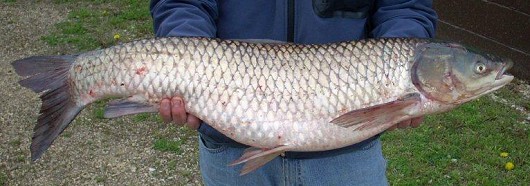Grass Carp
-
Scientific NameCtenopharyngodon idella
-
NativeNo
-
Identification
 Grass carp. Photographed on 05/13/08, by Konrad Schmidt, Nongame Fish Biologist, Division of Ecological Services, Minnesota Department of Natural Resources.
Grass carp. Photographed on 05/13/08, by Konrad Schmidt, Nongame Fish Biologist, Division of Ecological Services, Minnesota Department of Natural Resources.- Moderately slender but solid body with a wide scaleless head and terminal mouth
- Large scales outlined in black and most with a black spot at their base
- Silvery white appearance with occasionally olive back and sides, a gray head, a white to yellow belly, and dark fins
- Short spineless dorsal fin with its origin in front of the pelvic fin
- 8 dorsal, 9 anal, 18-20 pectoral, and 8 pelvic fin rays
- 34-45 scales on the lateral line
-
Life History
Grass Carp are most common in the backwaters and shallow areas of large, temperate river systems but can also be found in ponds, irrigation canals, and lakes. They are incredibly resilient to extreme conditions, capable of living in temperatures anywhere between freezing and 39°C, water with dissolved oxygen levels less than 1 mg/L, and in salinities higher than 17 g/L. Grass Carp are an omnivorous species but plants make up the majority of their diet and become even more dominant as individuals get larger. Submerged macrophytes and other soft plants are the Grass Carp’s meal of choice but they will eat the entirety of whatever plants are available before moving on to invertebrates like crustaceans and clams. This is an interesting behavior because their intestine is short and poorly adapted to digest this difficult material. Instead Grass Carp are forced to feed constantly in order to get the nutrients they need from these plants. Grass Carp will travel as much as hundreds of kilometers before establishing in an area that is rich enough in food to support their diet. Juveniles are not as dependent on plants and instead feed mainly on aquatic invertebrates from both the bottom and the plankton-rich midwater. This lasts until they reach 3-4 cm in length at which point they begin focusing on plant material instead.
Grass Carp will mature at various rates depending on temperature but, in general, they will be ready to spawn by they time the reach 60-70 cm in length and 4-5 kg in weight. Mating begins in summer when temperatures exceed 18°C and water levels begin to rise. Females will then find an area of moderate current to deposit their suspended eggs for the school of following males to fertilize. Females will lay anywhere between 237,000 and 1.7 million eggs in a single season depending on their size. These eggs hatch into pelagic larvae which will soon transform into juveniles and swim to shallow water. Over the next 4 years they will grow between 36 cm and 40 cm, add another 6-7 cm for each of the next 3 years, and 2-5 cm per year after that. Some may grow more in weight than their length would suggest and individuals have been found to weigh over 5 kg in only two years. It is not uncommon for these fish to live for up to 15 years and grow to lengths of 1-1.5 m and weights of 30-36 kg.
-
Links to Other ResearchN / A
